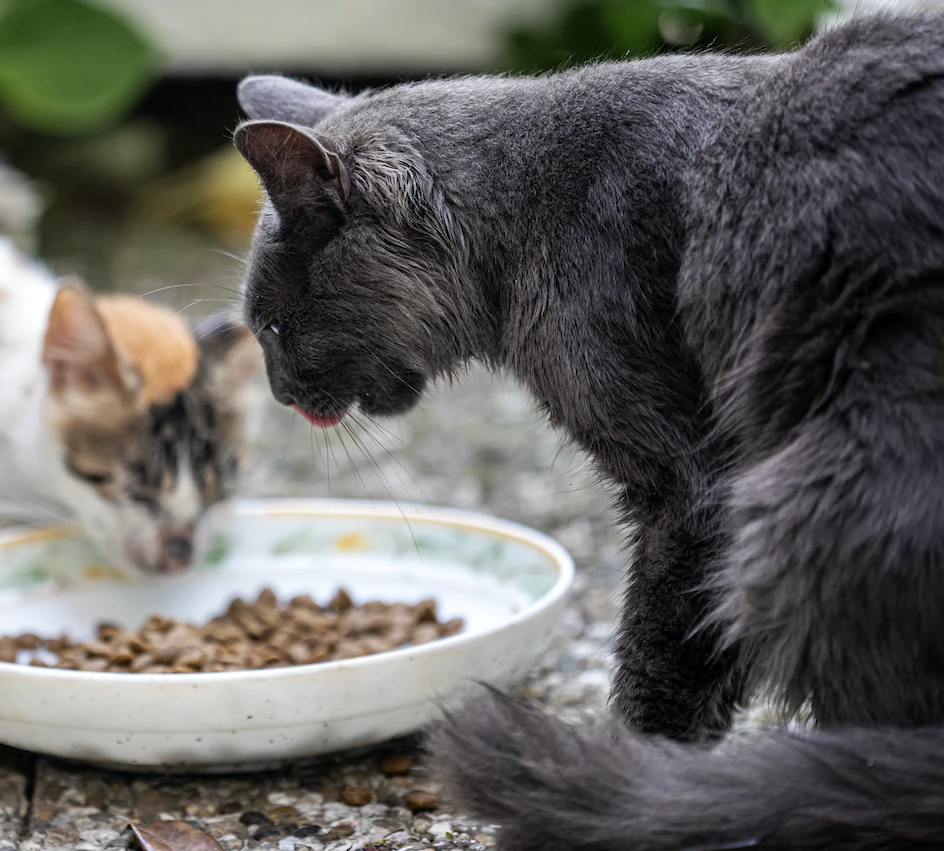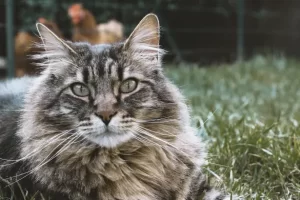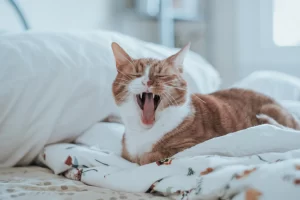Last updated on January 22nd, 2023 at 05:48 am

Cats are classified as obligate carnivores. This means they derive all of their sustenance from consuming other animals. Cats do not eat fruits or vegetables in the wild. This may make you wonder why there aren’t many cat foods with a pork as the main ingredient. So, can cats eat pork?
Yes, your cat can eat pork. A small amount of pork fed to your cat on occasion will not cause any health issues. However, it is not the ideal option and might produce complications if used too frequently. A cat’s nutrition, like that of any other living thing, is critical to its general health. You are what you consume. It’s the same with animals, and it’s seen in their fur, energy, feces, and weight. As a result, we must remain attentive to any changes in those factors. If you intend to offer this fatty pork treat to your cat, keep reading to learn about the precautions you should take and alternatives that may be better for your pet.
Nutritional Statistics of Pork
Depending on the cut, it can have low, medium, or high levels of fat and is an excellent source of iron and B vitamins. A 100g of pork contains:
| Calories | 297 |
| Protein | 7g |
| Water | 53% |
| Carbohydrates | 0 |
| Fats | 20.8g |
Pork is abundant in protein and can be included in a well-balanced diet. Protein is extremely vital for the body’s muscle and tissue upkeep and repair. It aids in the development of healthy muscle, which can improve physical function and performance.
Other advantages of pork include taurine, creatine, and beta-alanine, which are beneficial to muscular function, fatigue reduction, and athletic performance. Pork is high in B vitamins, which are essential for energy, metabolism, brain function, and DNA synthesis. It also contains iron, which is required for the transport of oxygen within red blood cells.
Can Cats Eat Cooked Pork?
Let’s make this clear, cats should only eat pork that has been completely cooked and is organic, with no added ingredients or preservatives. A study published in the Journal of the American Veterinary Medical Association discovered that viruses in raw pork can make your cat sick.
Pork intended for the rest of your family should never be fed to your cat under any circumstances. You must cook the pork without adding any additional salts or fats to the meat, as the flesh already contains a large amount of salt. This is how to properly prepare pork for cats.
Check to see whether the meat has been treated in any manner if it is of high quality and if it contains any additives or preservatives. Garlic and onion powders, for example, should not be added. In a pressure cooker, instead of using oil, finish the cooking process using water. It can be diced into bite-sized pieces or minced and combined with other key vitamins and minerals.
Benefits of Pork to Your Cat
Remember that if you feed pork to your cat in moderation, they can reap a plethora of benefits from this meat delight. The following are some of the advantages of feeding pork to your cat:
- High Protein Source. Pork is particularly high in protein, which is a vital ingredient for carnivores like cats. However, leaner choices, such as chicken, are substantially higher in protein and can be served more frequently.
- Pork contains B vitamins and minerals such as B1, B2, B6, and B12, as well as selenium, potassium, phosphorus, niacin, and zinc. Cats require B12 (cobalamin) to function properly in their neurological system, immunological system, and digestive tracts.
Meat is an important element of your cat’s diet, but pork is not the same as chicken or turkey and should not be the primary source of protein for your cat. When compared to other meats, pork has an extraordinarily high-fat content. Excess fat promotes weight gain and obesity, increasing your cat’s risk of diabetes or early-onset joint illness.
With a higher fat level, there is less protein in the portion of pork since the protein has been replaced by fat. This means that pork will provide less nutritional value to your cat than other meats. Too much fat can also raise the risk of pancreatitis in cats, which is an inflammation of the pancreas that causes vomiting, diarrhea, and abdominal pain. This ailment can be moderate and transitory, or it can be severe and require cats to be hospitalized for treatment.
The high salt content of pork is another issue. Cats are more sensitive to salt than humans, so too much can induce dehydration or, in extreme situations, salt poisoning, which can make them extremely ill. Raw pork should never be served to cats since it may carry parasites. Trichinella, a roundworm, and Taenia, a tapeworm, are both regularly found in raw pork but are killed during the cooking process.
If these worms are swallowed, they can proliferate in your cat’s digestive tract, causing an upset stomach, weight loss, and increased appetite. Pork bones and ribs are hazardous to cats because they can induce choking or become lodged in the digestive tract, causing an obstruction. Other processed pork items, such as pork sausages, should be avoided. Hog rinds are essentially just pork fat, so they are not suitable for cats.
Why Cats Shouldn’t Eat Fat and Sodium-Rich Foods?
As previously stated, the biggest issue with pork is its high fat and sodium levels. Cats require a complex nutritional and vitamin balance. This is made easier for humans by high-quality cat food brands, but giving them human meals and treats can easily upset the balance.
Pork’s high-fat content can lead to major health issues. Domestic cats are well-known for gaining weight when given the opportunity. Fatty deposits form in their arteries, excess weight harms their bodies, and it’s difficult to persuade them to be active and lose weight when they want to sleep most of the day.
Too much sodium in their diets causes thirst and puts additional strain on their kidneys, liver, and heart. Again, while all of this may sound frightening, a small amount of pork here and there isn’t enough to create major health problems. So, don’t feel bad if you occasionally give your cat some leftover bacon or pork.
How Much Pork Can A Cat Consume?
You should only let your cats eat pork in small amounts as a treat, and treats should account for no more than 10% of your cats’ daily meal intake. A few small pieces of cooked pork chop are acceptable, but no more.
How can you Feed Pork to Cat Safely?
There are a few measures you should take before feeding that piece of pork to your cat. Skipping these can make your cat’s treat far less healthful and may even offer some health problems.
Remove all of the bones
While dogs like chewing on a good bone, bones are solely a choking hazard for cats. That is why you must carefully remove all of the bones from any chunk of pork you offer your cat.
Cook everything thoroughly
If you’re going to feed your cat meat, make sure it’s properly cooked before you do. This is especially true when it comes to pork. Parasites that die off during the cooking process may be present in pork. If you don’t completely cook the ham, the parasites will survive and infest your cat.
Consume in Moderation
Because cats require a lot of protein and eat primarily meat-based diets, it seems paradoxical to limit the amount of pork you give your cat. Since it is not the healthiest option, even if it is meat, you still have to feed it moderately to cats. We have discussed the risk that comes with pork earlier in this article. Remember the 10% rule: all treats and human food should make up no more than 10% of your cat’s daily calorie intake.
What Pork to Feed Your Cat?
If you have made the decision to let your cats eat pork, then you should be aware of the different cuts that are available. Your cat’s diet should reflect the specific cut of pork that you select because they do not all have the same nutritional value. In general, you want to select the pork cuts that are the leanest possible and steer away from the pork cuts that are fatty. Always choose cuts like loin Chops, loin Roast, and pork Tenderloin and stay away from bacon, pork belly, and pork shoulder chops.
What if my Cat is Used to Eating a Lot of Pork on a Regular Basis?
In that situation, you must be alert to any changes in the cat’s behavior to detect signs of weight gain or sodium poisoning—a visit to the veterinarian is a good idea to monitor the cat’s true state. Keep track of your weight at all times. Obesity can create a variety of issues and may even reduce your cat’s life.
However, it is time for you to take charge of what you feed your pet because they eat what you give them. They are unable to walk to the supermarket and purchase meat. They devour whatever we feed them. As a result, we must exert control over it.
Please be patient. Habits take a long time to form and even longer to break. Perhaps you will feel some strain and more activity, but consider this: how would you feel if your favorite cuisine was suddenly reduced to a serving of cereal? Isn’t that bad? So, please be patient.
If your cat develops significant weight gain or digestive difficulties, including diarrhea, after eating a few pieces of pork, discontinue feeding the meat and visit your veterinarian for further advice and guidance. Spoiled or raw meat may be harmful to your cat’s health. Don’t feed anything to your cat if you wouldn’t eat it.
Alternatives to Pork that are Healthier
As previously said, there are various healthier options for your cat. These alternatives are less greasy, have less sodium, more protein, and may even contain beneficial elements not found in pork.
Fish
Fish is high in protein and sometimes contains significantly less salt than hog items. Even better, you can catch fish fresh, ensuring that no additives have been added to the meat. Furthermore, fish is high in omega fatty acids, which have numerous benefits for your cat, including
- Anti-inflammatory properties.
- It lessens shedding.
- Encourages undercoat growth.
- Immune diseases are avoided.
- Some cancers shrink.
- Treats certain kinds of epilepsy.
RELATED: Can Cats Eat Raw Fish?
Chicken
Chicken is inexpensive, lean, flavorful, and high in protein. That is why it is the primary protein source in so many cat meals. However, if you offer it to your cat straight, it can still make a wonderful treat. Just make sure it’s completely cooked and free of skin and seasonings.
Conclusion
Unlike chicken and fish, pork isn’t something that we normally feed to cats. And, if you want your cat to experience the taste, you need to do some precautions and follow the safety protocols like choosing the part of the pork that is better, removing any bones, cleaning up, and of course, monitoring your cat. Cats need meat to live, just like people do, and they like pork just as much as we do. But if you want to give them a well-balanced diet, you shouldn’t feed them pork very often. Make sure your pets are safe. Feed them with care to avoid problems in the future. Note the weight, the fur, and the poop so you can find out problems quickly if something changes.


